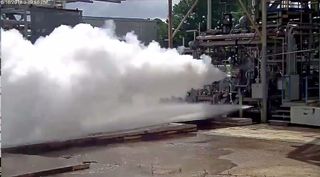Blue Origin opens new rocket engine factory in Alabama

The engine for Blue Origin's lunar lander, which has been in development for several years, will be tested at NASA's Marshall Space Flight Center among a crop of engines coming from the company's brand-new engine factory in Huntsville, Alabama.
The engine manufacturing facility opened in Huntsville, also known as "The Rocket City," on Feb. 17. In addition to the BE-7 engines that will be used in Blue Origin's lunar lander, the factory will produce BE-4 and BE-3U engines, all of which will go on to be tested at NASA's Marshall Space Flight Center, also in Huntsville.
Blue Origin is excited by how this new facility and new testing will advance their spaceflight capabilities. "At the core of every successful launch vehicle program are the engines that power those vehicles to space," Blue Origin CEO Bob Smith said in a statement. He continued, "it's an exciting time for Blue, our partners and this country — we are on the path to deliver on our promise to end the reliance on Russian-made engines."
Related: Blue Origin's Blue Moon Lander: A Photo Tour
The engines from this facility, along with the BE-7, will make their way to Marshall Space Flight Center.
But, while the engines from the new facility will be tested at Marshall on test stand 4670, the BE-7 will be tested at an Air Force Research Laboratory (AFRL) facility at Edwards Air Force Base in California. The "AFRL facility was chosen as a perfect fit for the BE-7 engine thrust rating, physical size and existing capability to test a space engine in vacuum," Eric Blumer, senior director for the BE-7 engine at Blue Origin, told Space.com in an email.

The facility already has some capabilities to create a "space-like" environment for testing. "The test site 1-42 at Edwards AFB [Air Force Base] can already test small engines in a "space-like" vacuum environment," Blumer said. But the facility is also being modified to test the BE-7.
Get the Space.com Newsletter
Breaking space news, the latest updates on rocket launches, skywatching events and more!
"The major facility modification being funded by Blue Origin is to add liquid hydrogen and liquid oxygen propellant capabilities," he added.
Though testing the BE-7 is the primary purpose of these upgrades, the newly improved facility also will be used to test other pieces of hardware and engines.
"Blue Origin does plan to 'piggyback' parts of the lander that interface to the BE-7 engine to reduce vehicle integration risks and mature the vehicle parts with engine interfaces along with the engine," he said. In other words, some of the pieces that will be tested at this facility, other than the BE-7, will be parts of the lander itself that will join with the lander's engine.
- Lunar Base and Gateway Part of Long-Term Human Exploration Plan
- Lockheed Martin Proposes 'Early Gateway' to Put Astronauts on Moon
- Elon Musk Jabs Jeff Bezos Over Blue Origin's Moon Lander
Follow Chelsea Gohd on Twitter @chelsea_gohd. Follow us on Twitter @Spacedotcom and on Facebook.
Join our Space Forums to keep talking space on the latest missions, night sky and more! And if you have a news tip, correction or comment, let us know at: community@space.com.

Chelsea “Foxanne” Gohd joined Space.com in 2018 and is now a Senior Writer, writing about everything from climate change to planetary science and human spaceflight in both articles and on-camera in videos. With a degree in Public Health and biological sciences, Chelsea has written and worked for institutions including the American Museum of Natural History, Scientific American, Discover Magazine Blog, Astronomy Magazine and Live Science. When not writing, editing or filming something space-y, Chelsea "Foxanne" Gohd is writing music and performing as Foxanne, even launching a song to space in 2021 with Inspiration4. You can follow her on Twitter @chelsea_gohd and @foxannemusic.
